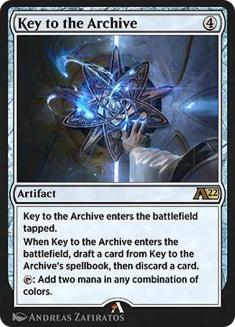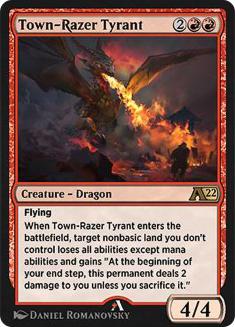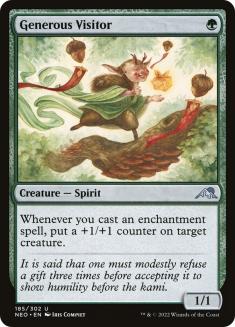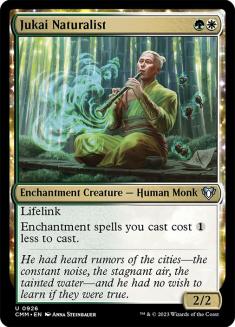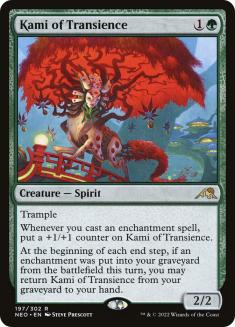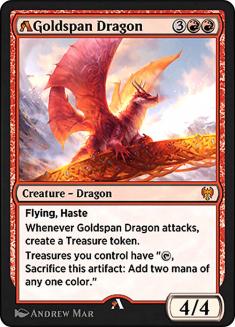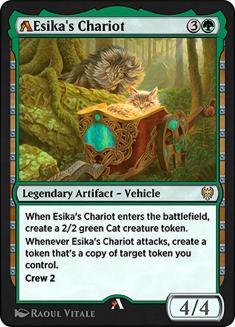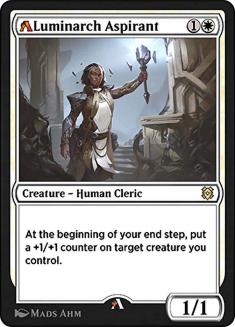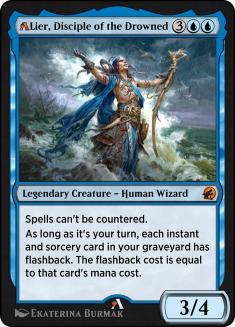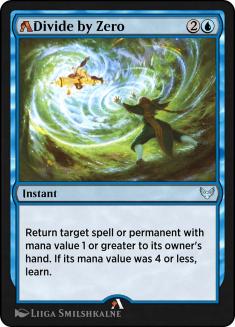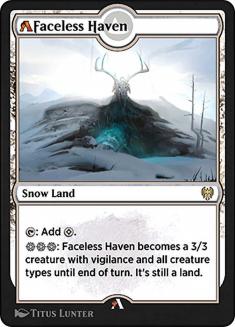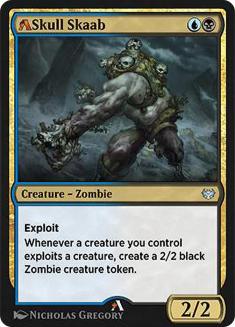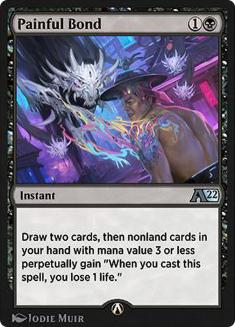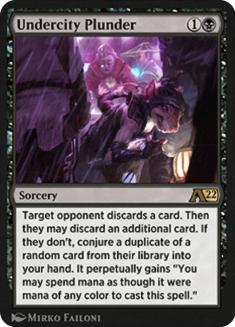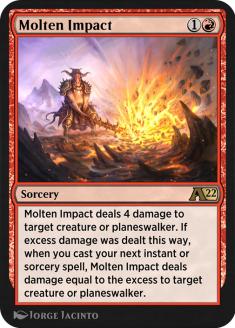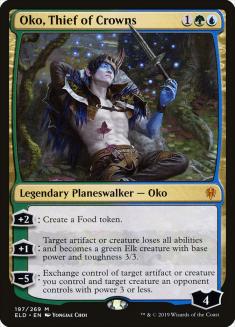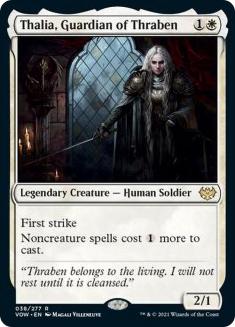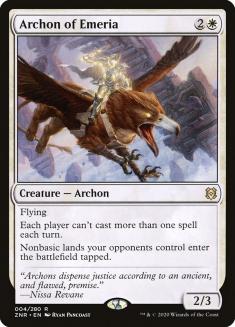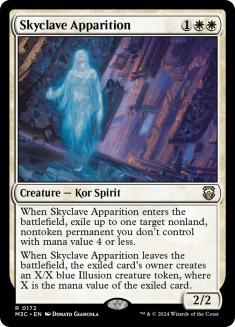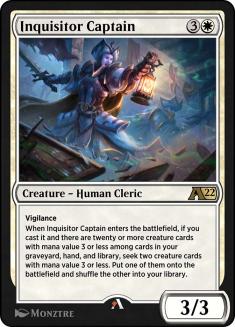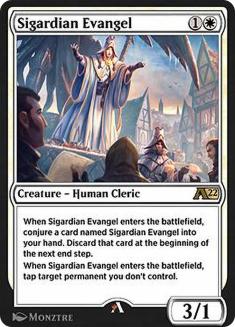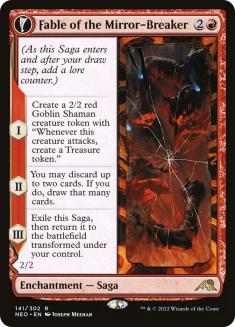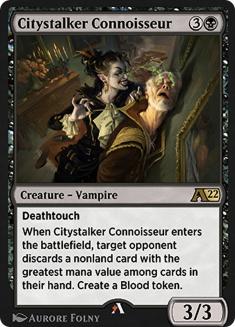Alchemy launched with more of a whimper than a bang. Even if you were excited to play Alchemy, where were you meant to do it if you didn’t want to wait for minutes to be paired with a faceless opponent on the ladder? A month and a half in, the Arena Open and the Qualifier Weekend finally defined a young format that was about to change again in a big way.
Alchemy’s Evolution
Indeed, this first batch of results showed just how the Alchemy-exclusive cards could warp Alchemy relative to Standard. Azorius Control with Key to the Archive and Divine Purge was all the rage at first, until Frank Karsten reminded the world that you forget about aggro at your peril.
The next week, Gruul Werewolves headlined by Tenacious Pup and Rahilda, Wanted Cutthroat alongside Town-Razer Tyrant was the deck to beat… and seemingly the only real deck in Alchemy.
Neon Shock
Kamigawa: Neon Dynasty turned every format on its head, and Alchemy was no exception. The Naya Runes deck – built almost entirely from Kamigawa and Kaldheim cards – quickly emerged as the most powerful deck in a vacuum and the ideal predator for Gruul Werewolves. Aggro expert Simon Nielsen was keeping the deck secret for the Neon Dynasty Championship, lost in the finals of a Set Championship Qualifier to someone else who had found the deck, and promptly went undefeated with it in the next qualifier, winning many mirrors along the way. The jig was up. Runes was by far the most popular deck in every third-party tournament from then until the Set Championship.
This new snapshot of Alchemy was one where the Alchemy cards barely registered. You could play your exact Naya Runes deck in Standard – and many people did, to some success, despite making no changes! The big difference here was the competition.
In Standard, Runes was just one strong deck in a sea of many. In Alchemy, almost all of those other decks were weakened or unplayable because their key cards had been rebalanced. Perhaps this should have been a sign that Runes’s early dominance was less because of its inherent strengths than because it was the best by default.
New Balance
A handful of cards stood out as examples of successful rebalancing. Alrund’s Epiphany went from deserving a ban in Standard to being unplayable in a mostly weaker format, but its partner-in-crime Divide by Zero landed as a playable but not oppressive card. Faceless Haven’s trajectory was similar – an incentive to play a monocolored deck, but not one that crowded out everything else.
The en masse rebalancings initially seemed like they would miss the mark thematically, but teams that considered the cards case-by-case found some diamonds in the rough. The Orzhov Venture deck that eventual winner Eli Kassis dominated Alchemy with isn’t a dedicated dungeon deck; instead, it leans on select dungeon cards in an otherwise unremarkable midrange deck.
The main thing that stopped more Alchemy cards from showing up is that we didn’t get to play with them. This was the Set Championship for Kamigawa: Neon Dynasty and the competitive debut for Alchemy, and yet it didn’t feature the Alchemy: Kamigawa cards – a baffling decision that made the results from this tournament obsolete immediately when that expansion released days later. In the Alchemy tournaments that have occurred since then, Rakdos Midrange powered by these new additions has put up incredible results, prompting the question of how different Alchemy could have looked on the big stage.
Hidden Information
This lack of grassroots interest and tournament support for Alchemy made preparing for the tournament a unique puzzle – there were so few decklists available that the Alchemy section on most decklist aggregation sites was empty! During the Arena era, a common complaint about these tournaments was that they occurred too late in the format and the sheer volume of games played on Arena had already uncovered the best strategies anyway; competitors rarely got to play a format that felt fresh. Although the reasons behind it weren’t encouraging, this format felt like uncharted territory for the first time in a while.
What little public information we did have pointed to this being another one-deck format. In the last few years of Standard, there had often been a single dominant strategy registered by a majority of players. The previous iterations of Alchemy had followed that trend – first Azorius Control, then Gruul Werewolves – and this one looked no different. If you can’t beat them – and you probably couldn’t – you had to join them.
In the end, everyone beat Runes. The deck posted a sub-40% win percentage and put nobody in the Top 8. What happened?!
Mono-White Aggro
Creatures (31)
- 4 Thalia, Guardian of Thraben
- 4 Skyclave Apparition
- 4 Archon of Emeria
- 2 Elite Spellbinder
- 1 Brutal Cathar
- 1 Fleeting Spirit
- 4 Hopeful Initiate
- 4 Inquisitor Captain
- 4 Sigardian Evangel
- 3 Luminarch Aspirant (MTGA)
Planeswalkers (2)
Lands (25)
Spells (2)

Mono-White Aggro jumped Naya Runes to become the most popular deck at the tournament, and still boasted an impressive win rate despite that.
Naya Runes pushed out pure aggro decks like Gruul Werewolves that couldn’t interact meaningfully with it and saw their creatures outclassed by giant lifelinkers. This version of Mono-White Aggro has a slow clock in the abstract but gets to staple disruption to its creatures, buying the time it needs to finish the job (Five-Color Humans feasting on combo during its heyday in Modern is a good comparison here). This is underscored by the move away from Usher of the Fallen and the emphasis on other three-drops over a card like Adeline, Resplendent Cathar, which applies more pressure than any of its competitors but doesn’t do anything more than that.
Archon of Emeria was touted as the silver bullet for beating Runes. Popular streamer Mystmin went as far as splashing Archon in their Rakdos Sacrifice deck. The card was as good as advertised there and accidentally good against other opponents; the Grixis and Mardu Midrange decks that took over the tournament are full of nonbasic lands and Archon can wreak havoc with their sequencing. If you had to run back Mono-White Aggro for this exact field, it wouldn’t make your maindeck, but its floor is reasonably high.
Alchemy’s Secrets
Without Alchemy results to sift through, it was only natural that people would look to Standard. Mono-White Aggro had been the best deck there for a while too and was an easy deck to transfer to Alchemy if you didn’t want to play Runes but were at a loss for other options. Luminarch Aspirant was a key part of the Standard list – though Jonny Guttman secured a spot at Worlds with the nerfed version in his Alchemy version – but the Alchemy additions more than made up for it.
Inquisitor Captain made a name for itself early with the goal of flooding the battlefield via Glasspool Mimic, but this updated version is still incredible as the curve-topper for an aggro deck. Sigardian Evangel is not just a two-drop to fill the void left by Luminarch Aspirant but the ideal finisher in any longer game – as a four-drop it adds six power to the battlefield and removes blockers for your existing creatures, making it much more likely that your larger army would be lethal the following turn. If you took your Standard Mono-White list and had the good sense to add four Captains and four Evangels, you were far ahead of most players at the Set Championship.
Mirror-Breaker
Creatures (15)
- 3 Skyclave Apparition
- 2 Archon of Emeria
- 2 Valki, God of Lies
- 1 Tainted Adversary
- 4 Citystalker Connoisseur
- 3 Triumphant Adventurer (MTGA)
Planeswalkers (4)
Lands (26)
Spells (15)

Creatures (15)
- 2 Graveyard Trespasser
- 4 Bloodtithe Harvester
- 4 Citystalker Connoisseur
- 2 Town-Razer Tyrant
- 3 Rahilda, Wanted Cutthroat
Planeswalkers (5)
Lands (26)
Spells (14)

The real surprise of the tournament was a pair of unlikely co-stars. Fable of the Mirror-Breaker has found a home in my formats already and is a strong card, but not one that you would want to splash for alone – unless it threatened to end the game reliably.
Enter Citystalker Connoisseur. Reflection of Kiki-Jiki lets you make a copy of Connoisseur in the opponent’s draw step, sniping their freshly drawn card if they were empty-handed and locking them out of casting any spells at sorcery speed. This combo isn’t appealing if the individual pieces aren’t, but Citystalker shines by itself too, as shown by its performance in Kassis’s triumphant Orzhov deck. It ticked every box against Runes – the discard trigger hit their main card advantage engine in Showdown of the Skalds and the deathtouch body threatened to trade with their biggest creature – and is a card you’re happy to see against everyone else.
This combo is a great illustration of what’s possible in Alchemy. A promising card from the newest Standard set teamed up with a pushed Alchemy design for a result that isn’t possible in any paper format. Decks building on this Rakdos base were the big success story of the tournament and have only improved with the Alchemy: Kamigawa cards. You have to look long and hard to find a Runeforge Champion or Inquisitor Captain in the recent results.
Past and Future
Nobody could feel entirely satisfied about their Alchemy preparation. Most Mono-White Aggro players missed the mark on Fable + Connoisseur; the team that put young Zach Dunn in the finals with their Fable + Connoisseur deck didn’t even have Mono-White Aggro on their radar! The black midrange decks that did emerge were quite untuned and were quickly rebuilt by players who found themselves back in the trenches hoping to qualify again. The Japanese team that dominated the Innistrad Championship and had the highest Historic win rate here with an innovative Azorius Yorion deck flopped in Alchemy, falling into the trap of running Runes.
The future of Alchemy is unclear right now. It doesn’t have a guaranteed slot at the New Capenna Set Championship. Independent tournament organizers have little incentive to promote Alchemy because there’s little interest among the player base. It’s hard not to view this launch as a missed opportunity of sorts – even if its first performance on the big stage went surprisingly well.


